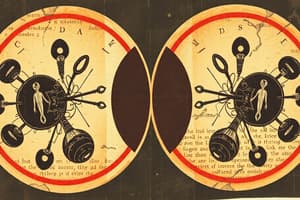Podcast
Questions and Answers
What is the primary purpose of mitosis in multicellular organisms?
What is the primary purpose of mitosis in multicellular organisms?
- Generating genetic diversity through crossing over
- Growth and repair of tissues (correct)
- Reducing the chromosome number by half
- Production of gametes for sexual reproduction
Meiosis results in two diploid daughter cells.
Meiosis results in two diploid daughter cells.
False (B)
During which phase of meiosis does crossing over occur, and what is the significance of this process?
During which phase of meiosis does crossing over occur, and what is the significance of this process?
Crossing over occurs during prophase I of meiosis. It results in genetic recombination, increasing genetic diversity in the offspring.
In mitosis, sister chromatids separate during ______, while in meiosis I, homologous chromosomes separate during ______.
In mitosis, sister chromatids separate during ______, while in meiosis I, homologous chromosomes separate during ______.
Match the following phases with their descriptions:
Match the following phases with their descriptions:
Which of the following events occurs during metaphase in both mitosis and meiosis II?
Which of the following events occurs during metaphase in both mitosis and meiosis II?
A cell with 20 chromosomes undergoes mitosis. How many chromosomes will each daughter cell have?
A cell with 20 chromosomes undergoes mitosis. How many chromosomes will each daughter cell have?
Describe one significant difference in the outcomes of mitosis versus meiosis, relating to genetic variation.
Describe one significant difference in the outcomes of mitosis versus meiosis, relating to genetic variation.
Which process is responsible for generating genetically diverse daughter cells?
Which process is responsible for generating genetically diverse daughter cells?
Stabilizing selection always leads to the formation of new species.
Stabilizing selection always leads to the formation of new species.
Briefly explain how sexual selection can lead to sexual dimorphism.
Briefly explain how sexual selection can lead to sexual dimorphism.
In a pedigree diagram, ______ represent affected individuals.
In a pedigree diagram, ______ represent affected individuals.
Match the type of natural selection with its effect on phenotypes:
Match the type of natural selection with its effect on phenotypes:
In an autosomal dominant inheritance pattern, what is the probability that a child will be affected if one parent is heterozygous for the trait and the other is unaffected?
In an autosomal dominant inheritance pattern, what is the probability that a child will be affected if one parent is heterozygous for the trait and the other is unaffected?
X-linked recessive traits are more commonly expressed in females than in males.
X-linked recessive traits are more commonly expressed in females than in males.
Explain why antibiotic resistance in bacteria is an example of directional selection.
Explain why antibiotic resistance in bacteria is an example of directional selection.
In a pedigree diagram, horizontal lines connect ______.
In a pedigree diagram, horizontal lines connect ______.
Which type of natural selection is most likely to lead to the formation of new species?
Which type of natural selection is most likely to lead to the formation of new species?
Flashcards
Mitosis
Mitosis
Cell division producing two identical diploid cells.
Meiosis
Meiosis
Cell division producing four genetically different haploid cells.
Mitosis Function
Mitosis Function
Growth, repair, and asexual reproduction.
Meiosis Function
Meiosis Function
Signup and view all the flashcards
Interphase
Interphase
Signup and view all the flashcards
Prophase
Prophase
Signup and view all the flashcards
Anaphase
Anaphase
Signup and view all the flashcards
Crossing Over
Crossing Over
Signup and view all the flashcards
Natural Selection
Natural Selection
Signup and view all the flashcards
Directional Selection
Directional Selection
Signup and view all the flashcards
Stabilizing Selection
Stabilizing Selection
Signup and view all the flashcards
Disruptive Selection
Disruptive Selection
Signup and view all the flashcards
Sexual Selection
Sexual Selection
Signup and view all the flashcards
Pedigree Diagrams
Pedigree Diagrams
Signup and view all the flashcards
Autosomal Dominant
Autosomal Dominant
Signup and view all the flashcards
Autosomal Recessive
Autosomal Recessive
Signup and view all the flashcards
X-Linked Dominant
X-Linked Dominant
Signup and view all the flashcards
X-Linked Recessive
X-Linked Recessive
Signup and view all the flashcards
Study Notes
- Mitosis and meiosis are both forms of cell division but result in different outcomes.
- Mitosis produces two identical daughter cells, while meiosis produces four genetically different daughter cells.
- Mitosis is involved in growth, repair, and asexual reproduction; meiosis is involved in sexual reproduction and genetic diversity.
Mitosis
- Mitosis is a type of cell division resulting in two daughter cells, each having the same number and kind of chromosomes as the parent nucleus.
- Mitosis is typical of ordinary tissue growth.
- Mitosis can be divided into phases; prophase, metaphase, anaphase, and telophase
- Interphase precedes mitosis however is technically not part of mitosis
- During interphase cells grow and replicates its DNA
- Chromosomes condense and become visible during prophase
- The nuclear envelope breaks down and spindle fibers form during prophase
- During metaphase chromosomes line up along the metaphase plate, which is the center of the cell
- Sister chromatids separate and move to opposite poles of the cell during anaphase
- During telophase chromosomes arrive at opposite poles, and new nuclear envelopes form around them
- During cytokinesis the cytoplasm divides, resulting in two identical daughter cells.
Meiosis
- Meiosis is a type of cell division resulting in four daughter cells each with half the number of chromosomes of the parent cell
- Production of gametes and plant spores happens during meiosis
- Meiosis involves two rounds of division: meiosis I and meiosis II.
- During prophase I chromosomes condense
- Homologous chromosomes pair up and exchange genetic material via crossing over during prophase I
- During metaphase I homologous chromosome pairs line up along the metaphase plate.
- During anaphase I homologous chromosomes separate and move to opposite poles.
- During telophase I chromosomes arrive at opposite poles; the cell divides, resulting in two haploid cells.
- During prophase II chromosomes condense.
- During metaphase II Chromosomes line up along the metaphase plate.
- Sister chromatids separate and move to opposite poles during anaphase II.
- Chromosomes arrive at opposite poles and the cells divide, resulting in four haploid daughter cells during telophase II.
Similarities
- Both mitosis and meiosis start with a single parent cell.
- Both processes involve stages such as prophase, metaphase, anaphase, and telophase.
- Both involve the separation of chromosomes.
- Both are preceded by interphase, during which DNA replication occurs.
Differences
- Mitosis produces two diploid (2n) daughter cells, while meiosis produces four haploid (n) daughter cells.
- Mitosis involves one round of cell division, while meiosis involves two rounds.
- Mitosis does not involve crossing over, while meiosis does which increases genetic diversity.
- Mitosis is for growth, repair, and asexual reproduction; meiosis is for sexual reproduction.
- The daughter cells in mitosis are genetically identical to the parent cell and each other, while in meiosis, the daughter cells are genetically different.
Types of Natural Selection
- Natural selection is a mechanism of evolution that favors individuals with advantageous traits, allowing them to survive and reproduce more successfully.
- Types of natural selection include directional, Stabilizing, Disruptive, and Sexual
Directional Selection
- Directional selection occurs when one extreme phenotype is favored over other phenotypes, causing the allele frequency to shift over time in the direction of that favored phenotype.
- Antibiotic resistance in bacteria is an example where bacteria with resistance genes survive and reproduce more than those without, shifting the population towards antibiotic resistance.
Stabilizing Selection
- Stabilizing selection favours intermediate phenotypes, reducing variation in a population.
- Extreme phenotypes are selected against in stabilizing selection
- Human birth weight is an example where babies with intermediate weights have higher survival rates than those with very low or very high weights.
Disruptive Selection
- Disruptive selection (or diversifying selection) favors both extreme phenotypes at the expense of intermediate phenotypes and can lead to increased variation in a population.
- Disruptive selection can lead to the formation of new species
- Finch beak sizes in an environment with only large and small seeds is an example where finches with intermediate beak sizes are less efficient at eating either type of seed.
Sexual Selection
- Sexual selection is a form of natural selection in which individuals with certain inherited characteristics are more likely than other individuals to obtain mates.
- Sexual selection can result in sexual dimorphism, where males and females of a species have different appearances or behaviors.
- Bright plumage in male peacocks is an example, which attracts females despite potentially increasing the risk of predation.
Pedigree Diagrams
- Pedigree diagrams are used to trace the inheritance of genetic traits or diseases through families.
- Standardized symbols represent individuals and their relationships using pedigree diagrams
- Squares represent males
- Circles represent females
- Shaded symbols indicate individuals affected by the trait or disease
- Unshaded symbols indicate unaffected individuals
- Horizontal lines connect parents
- Vertical lines connect parents to their offspring.
Autosomal Dominant
- Autosomal dominant traits appear in every generation.
- Affected individuals typically have at least one affected parent.
- If one parent is affected (heterozygous) and the other is unaffected, there is a 50% chance that each child will be affected.
- Both males and females are equally likely to be affected.
Autosomal Recessive
- Autosomal recessive traits often skip generations.
- Affected individuals usually have unaffected parents who are carriers (heterozygous).
- If both parents are carriers, there is a 25% chance that each child will be affected, a 50% chance that each child will be a carrier, and a 25% chance that each child will be unaffected and not a carrier.
- Both males and females are equally likely to be affected.
X-Linked Dominant
- X-linked dominant traits do not skip generations.
- All daughters of an affected father will be affected.
- Affected mothers (heterozygous) will pass the trait to 50% of their children (both sons and daughters).
- More females are typically affected than males.
X-Linked Recessive
- X-linked recessive traits are more common in males than females.
- Affected males inherit the trait from their mothers.
- Females are affected only if they inherit the trait from both parents.
- X-linked recessive traits can skip generations, appearing more frequently in males whose mothers are carriers or affected.
- Daughters of affected fathers are obligate carriers.
Studying That Suits You
Use AI to generate personalized quizzes and flashcards to suit your learning preferences.





